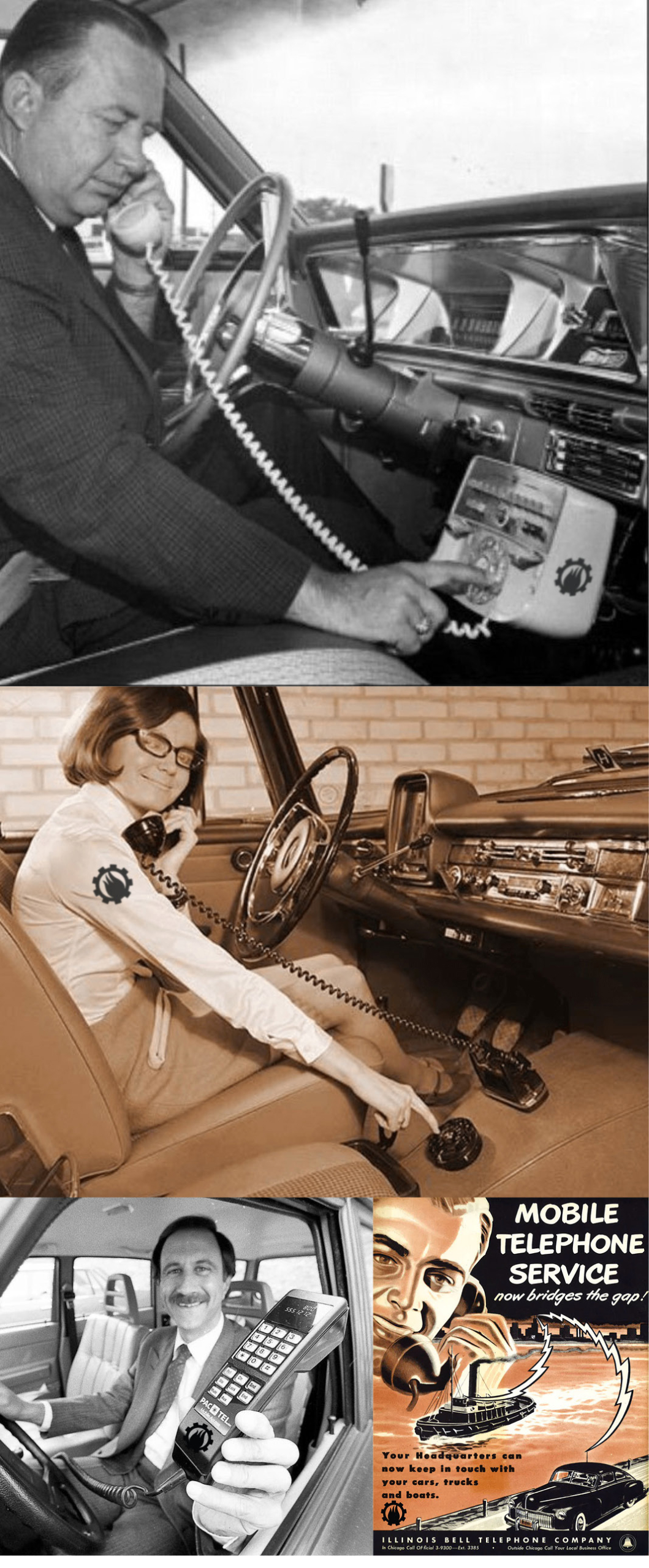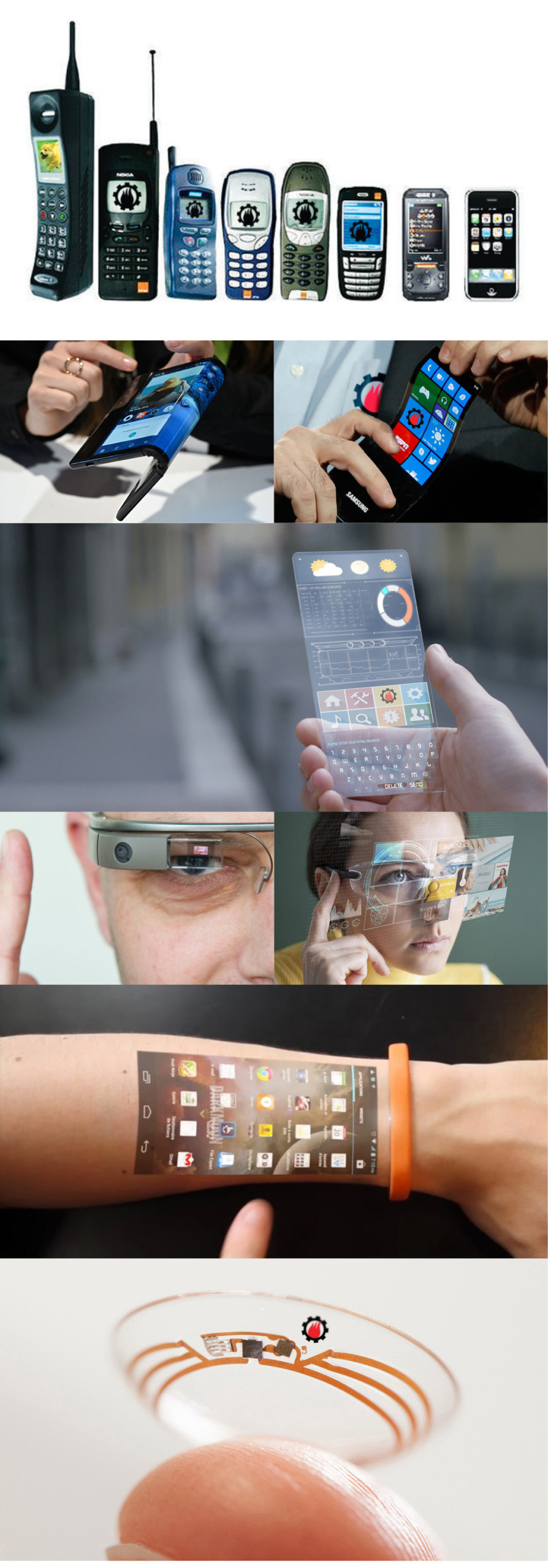75 Years Ago – Nice Call!


The car phone has come a long way, baby. From 80 pounds of equipment in the trunk to devices weighing ounces that are also great cameras, gaming platforms, email apps, and soooooo much more!!! Next you’ll be able to wear them and even see with them. Wow!!!!
Driving home, my phone rang through the car sound system. It was a call from Jackie asking me to stop and pick up some groceries we needed for dinner. Not taking my hands off the wheel, I was able to answer the call, talk with her, get the info and say goodbye. Think about it. A cell phone built into my car. People now take this type of technology for granted, but not so long ago it was firmly in the realm of science fiction. The transition from fantasy to reality was far from the flip of a switch. The amount of time, money, talent and effort required to solve PIA (Pain In The @#$) Jobs! goes far beyond any one product development cycle. Technology development really occurs on a timescale of decades. While the last steps of technological development capture headlines, it takes thousands of scientists and engineers working for decades on myriad technologies to get things to work correctly. Here’s some history on the invention of car phones. Thanks Smithsonian and Nevada Inventors for the info.
Here’s a classic from ELO to enjoy while reading.
- The first mobile phone service, for 80-pound telephones installed in cars, was demonstrated on June 17, 1946, that’s 75 years ago! The service was only available in major cities and highway corridors and was aimed at companies rather than individuals.
- The inventor of the car phone is Bell System Operating Companies, in 1946, an outcome of Bell Laboratories. Most of the equipment converted for the use of car phones were being experimented on, even before the second world war. Western Electric Type 28 VHF equipment radio equipment was used alongside Bell System equipment internally at that time.
- The equipment filled much of a car’s trunk, and subscribers made calls by picking up the handset and speaking to a switchboard operator. The earliest car phone services were connected to Public Switched Telephone Network. At that time, the American population’s mobility grew drastically; it was the postwar years—designs of phones committed into the hands of Western Electric Corporation.
- Western Electric Corporation was the major supplier of the phone sets to Bell System. Bell Laboratories built the phones’ overall system; they were responsible for setting specifications for the equipment.
- During this period, independent Telephone Companies were building their design and were supplied by Automatic Electric. Western Electric Type 38 and Type 39 VHF FM police radio equipment combined with Bell System equipment made a stylish telephone with a selective calling decoder.
- The decoder was designed to ring a bell in the automobile if any caller signaled the phone’s number. The decoder was enclosed in glass as a small wheel, having pins on some parts of its circumference. The decoders were originally built for signaling right-to-way for the railway. At some point, they were used in ships during radio installations in the 30s. The decoder development was a proven concept. It was named 102.
- The result of the successful testing of the equipment led AT&T to announce the creation of the General Mobile Radiotelephone Service in June 1945. With the authorization of the Federal Communications Commission (FCC), they established base stations. Cities, where based stations were first established, were Chicago, Salt Lake City, Milwaukee, Washington DC, Houston, Cincinnati, Pittsburgh, Denver, Philadelphia, New York City, Baltimore, Columbus, Ohio, and St. Louis.
- When the car phone was becoming a useful invention across the USA, Bell System and FCC concluded two forms of telephone service known as HIGHWAY and URBAN. Both services were VHF and used FM.
- A major impetus for developing mobile wireless technologies was the need during World War II for troops to communicate on the move in the field. The SRC-536 Handie-Talkie was developed by the predecessor to Motorola Corporation and used by the U.S. Army in the war. The Handie-Talkie was a two-way radio that was small enough to be held in one hand and resembled a telephone. Motorola went on to become one of the major manufacturers of cell phones.
- The story of military investment in technology becoming game-changing commercial products and services has been repeated again and again. Famously, the Defense Advanced Research Projects Agency (DARPA) developed the technologies behind the internet and speech recognition. They also made enabling investments in advanced communications algorithms, processor technology, electronics miniaturization and many other aspects of your phone.
- The highway service was made to serve the major routes of land and water across the USA at that time, for barges on waterways and trucks on the highway with private vehicles’ exemption. Twelve channels were allocated to highway service with low band VHF. Their mobile equipment received 35 Megacycle and was transmitting on 43 Megacycle frequencies.
- Urban service was serving subscribers who travel within the radius of an urban center. The service was available to workers in a major city, including doctors, ambulances, delivery trucks, news reporters, and other workers who met the requirements. Urban services operated on six channels initially, receiving on VHF 152 Megacycle and transmitting on 158 Megacycles. The need for separation in receiving and transmitting channels was so that a half-duplex communications circuit could be provided. It allowed the base stations to stay on air when a call is on.
- The urban system first went on air in St Louis in June 1946, while the highway system first went on air in Wisconsin in August 1946. Two years after the service was made available, urban service was accessible in 60 cities in the USA and Canada. They had 4000 subscribers at that time, and up to 12,000 calls were handled smoothly every month.
- Highway service was accessible across 85 cities, having 1900 subscribers, and up to 36,000 calls were handled every month. The service was mostly covering the Midwest and the east side.
- Bell System later went into business with the police department, renting them equipment for the police radio market. The rental service included maintaining and updating the equipment. Urban service was made available for smaller police departments.
- Car Phones have improved as well, and its development has led to the invention of mobile phones – first known as cellphones, and their service was limited due to power consumption and signal quality between “cell towers”. The first mobile phone services used small numbers of large radio towers, known as cellular base stations, which meant that all the subscribers in a big city shared one central base station. This was not a recipe for universal mobile phone service.
- The first handheld mobile phone was demonstrated in 1973, nearly three decades after the introduction of the first mobile phone service. It was nearly three decades after that before half the U.S. population had a mobile phone. Today the technology has advanced so significantly that I can be typing and sending this post from my phone!
- Whether we need to check the weather forecast, instantly message networks of family, friends and followers on social media, consult a variety of apps to help us with our business, or just entertain ourselves with our favorite games, music or videos, it’s fair to say that we all rely on our smartphones to come to our aid at the swipe of a touchscreen. So, will the future of smart phones be different? Here’s some predictions:
- Consumer demand dictates the speed of change. Future cell phone technology will have to reflect and keep up with an increasingly Internet-dependent world, as well as cope with shifting work trends. As such, faster wireless connectivity will be an absolute must.
- Videoconferencing, digital collaboration, and telecommuting have become central to our everyday working life, bringing with them a vital need for reliable connectivity and greater bandwidth. The future of smart phones revolves around being able to easily sync home and office experiences, instantly stream video content and unlock the potential of future smart technologies as the Internet of Things dictates.
- Flexible, stretchable display screens are likely to play a role in the future of cell phone technology. While consumers love larger screens, tablets are bulky, and for the sake of convenience, mobile phones need to fit into pockets. Foldable phones may to some extent fulfil this need.
- Mobile phone companies have hinted at a wearable future of smartphones – perhaps wrapped around the wrist, or transformed into a GPS-enabled belt clip, or as a pair of glasses (rumors have been increasingly circulating about the release of the Apple Glass, which may or may not fare better than the Google Glass, which ultimately failed a few years ago). Devices, indeed, could soon be totally reshaped according to individual needs. However, whilst the concept of flexible phones has been demonstrated at trade shows and exhibitions, manufacturers have been slow to bring wearable phones to market
- Increased uptake of mobile apps related to banking, retail and general commercial functions suggests that the future for cell phone technology lies in a greater adoption of mobile payment technologies, which effectively transform smartphones into credit card and contactless payment devices.
- It can be argued that traditional smartphone design has reached its limit – hence the emergence of foldable phones and expandable screens. The long-term future of cellular and mobile technology may well be wearable, but shorter-term, the future of smart phones will be increasingly intertwined with the Internet of Things, 5G-enabled, and supporting ever-more sophisticated apps to handle more and more of our payments and finances.
- All of this mobile technology will find its way into your automobile. Likely touchscreen and handsfree. It’s gonna be something.
::::::::::::::::::::::::::::::::::::::::::::::::::::::::::::::::::::::::::::::::::::::::::
DO YOU LIKE CONTESTS?
Me, too.
As you may know the Kowalski Heat Treating logo finds its way
into the visuals of my Friday posts.
I. Love. My. Logo.
One week there could be three logos.
The next week there could be 15 logos.
And sometimes the logo is very small or just a partial logo showing.
But there are always logos in some of the pictures.
So, I challenge you, my beloved readers, to count them and send me a
quick email with the total number of logos in the Friday post.
On the following Tuesday I’ll pick a winner from the correct answers
and send that lucky person some great KHT swag.
So, start counting and good luck!
Oh, and the logos at the very top header don’t count.
Got it? Good. :-))))
Have fun!!
::::::::::::::::::::::::::::::::::::::::::::::::::::::::::::::::::::::::::::::::::::::::::



Leave a Reply
Want to join the discussion?Feel free to contribute!